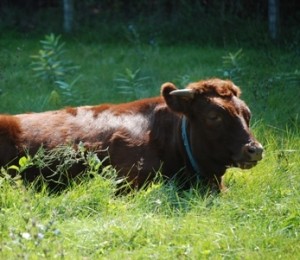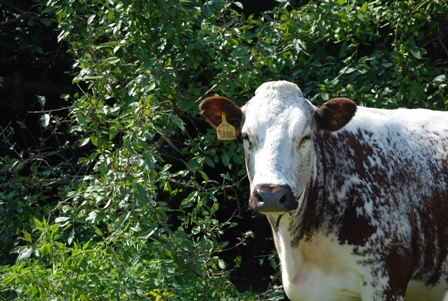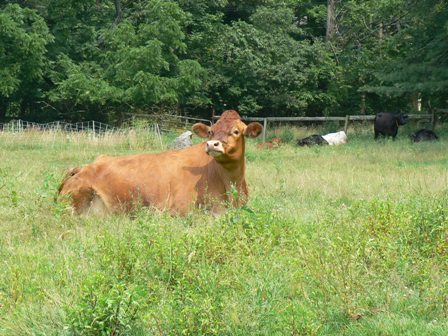No visit to Drumlin Farm is complete without stopping at the far end of the farmyard loop to check in on the cows. They may be lounging in the field, or huddled by the red barn for feeding time. And if you’re lucky, you may even witness a new calf being born in the spring or fall.

But have you ever wondered what type of cows they are, and why they were selected? We can explain. Of the 800-plus cattle breeds worldwide, Drumlin Farm usually has only 2-3 breeds on hand. When selecting which breeds we raise, there are a lot of factors to consider. Do we want beef cows, dairy cows, or both? Do we want big or small cows? And what is the breed’s historical status?
For small farms like Drumlin Farm, we can’t have a huge herd, so we want our cows to be able to multitask whenever possible. We also don’t have the room, or pasture, for extremely large cows. And, as a sustainable farm, we look to support Heritage breeds, which are breeds that have been historically raised and are now endangered due to industrialization.
With all those factors in mind, Drumlin Farm set its sights on two breeds: Dexter and American Lineback.
The Dexters
We currently have 4 Dexters in our herd (they’re the black or red ones). We chose Dexters because they are a Heritage breed that is slowly recovering, and they are great for both beef and dairy purposes. Since we’re a farm that appeals to families, we also love that the Dexters are a calm lot.


The American Linebacks
If you’ve ever taken a program at Drumlin Farm that involved milking a cow, you have already met “Jane,” the American Lineback. One look at her and you can see where the breed name comes from. She’s white with brown splotches and a very distinguishable white line running down her back.
American Linebacks are a great breed – manageable dairy cows that can produce a lot of milk. Jane recently became a mom, and even though she was bred with another true American Lineback, the calf lacks the “line,” so it isn’t considered a pure breed.
Speaking of American Linebacks, last summer, Farmer Caroline was checking on the cattle and noticed there was one too many American Linebacks in our field. Turns out, a neighbor’s cow wanted to hang out with our herd! Getting it back to its home was an interesting task (but we’ll save that story for another time).

The Odd One Out
We’ve covered the black and red cows and the splotchy brown-and-white cows, but what about that one brown cow, you ask? Well, that’s our Guernsey-Jersey steer (a steer is a bull that has been castrated).
He was actually supposed to be sent to market 3.5 years ago but was unwilling to step on the truck. So he received a “stay,” and we are glad he did. Turns out, he is great at letting the farmers know when the other cows are in heat, which tells us when it’s time to inseminate (breed) them.

Next time you are at the farm, take a few extra minutes to watch the cows and how they interact. You can watch our newest heifer, a red Dexter born in May, and you may see one of our black Dexters getting a little bigger. Tilly was bred on February 8, and if it took, she will be expecting around November 13.

